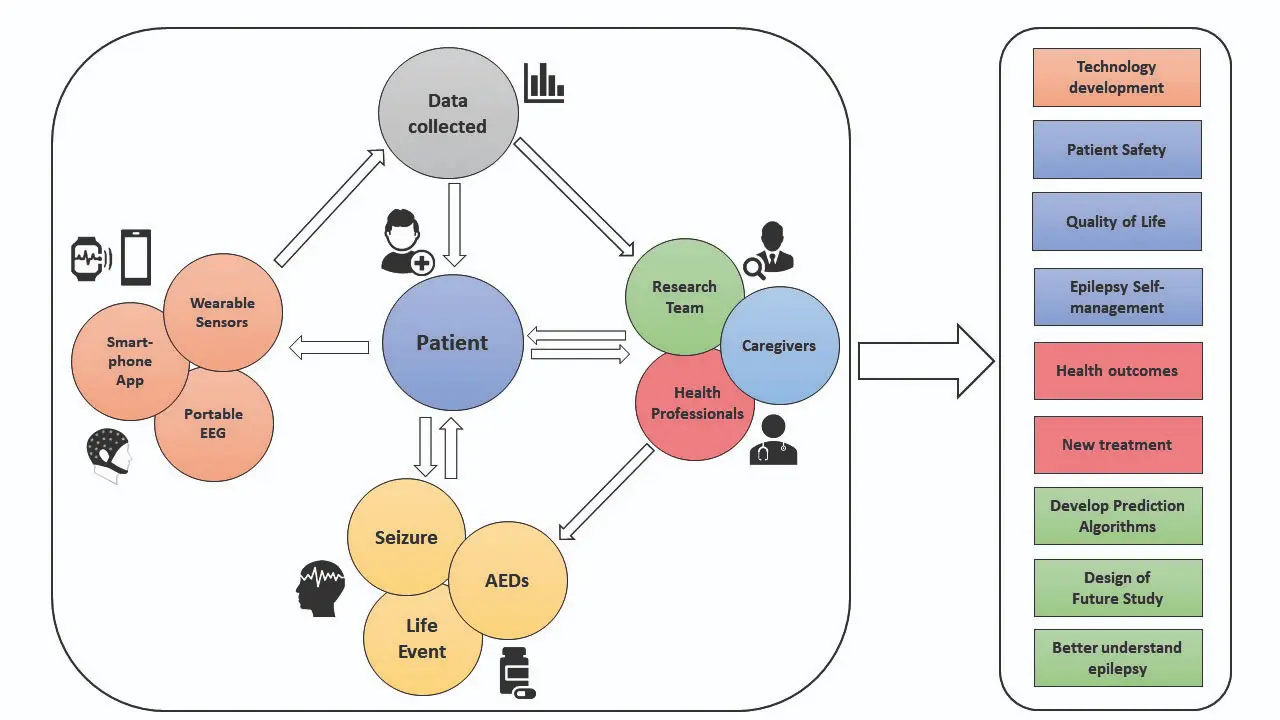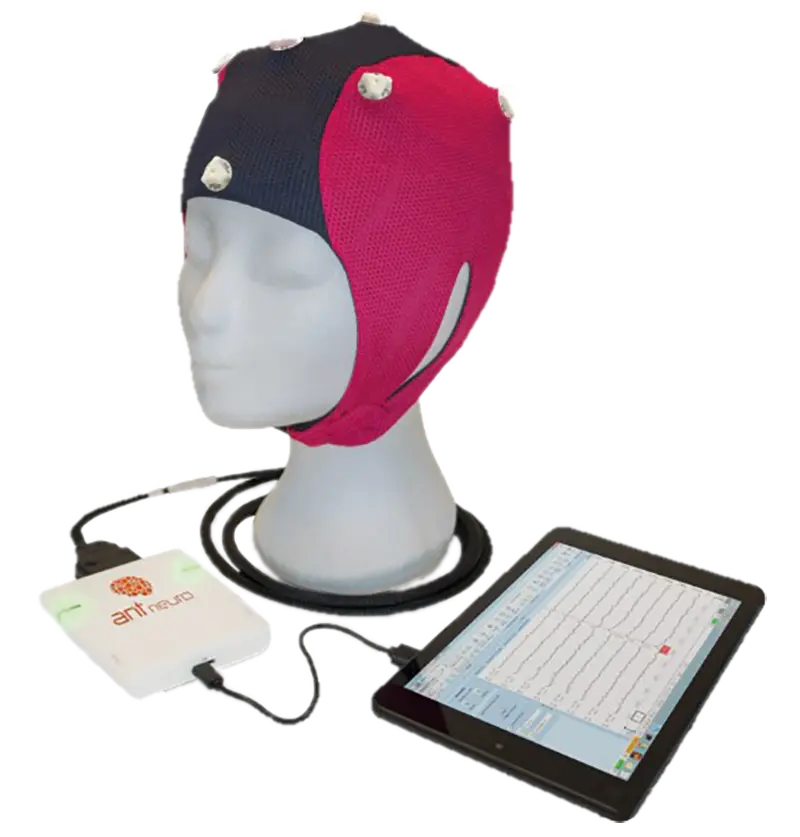The EEG@Home project, led by Andrea Biondi and the team at King’s College London, explores the feasibility of epilepsy patients independently performing regular physiological measurements from home. Using ANT Neuro’s eego™ 8-channel dry EEG system, a Fitbit Charge 3 smartwatch, and the Seer Medical app, participants track EEG, heart rate, sleep quality, mood, medication use, and seizure occurrences over a six-month period. This approach aims to improve seizure forecasting, personalize treatment, and enhance patient independence. The study addresses challenges in seizure self-reporting by combining wearable sensors, self-applied EEG, and mobile technology, potentially paving the way for reliable, long-term home monitoring and self-management in epilepsy care.
Contents
The EEG@Home project showcase: Independent physiological measurements of epilepsy patients from the comfort of their own homes Existing approaches in epilepsy management EEEG@Home Study Overview Technology to be used in the study Planned data analyses Innovative clinical endeavor Social media handles External links External links (Specific to researcher) References
The EEG@Home project showcase: Independent physiological measurements of epilepsy patients from the comfort of their own homes

Andrea Biondi is a research scientist and PhD candidate in Clinical Neuroscience at King’s College London, at the Maurice Wohl Clinical Neuroscience Institute. He has a background in psychophysiology, neuroscience and psychopathology and has been a research scientist for the Remote Assessment of Disease and Relapse in Central Nervous System Disorders (RADAR-CNS) Project. His core expertise includes data acquisition from EEG, EEG-TMS and EEG-fMRI setups, EEG, ECG and EMG data analysis as well as psychological and cognitive assessments. Andrea is currently working on the EEG@Home research project, under the supervision of Prof. Mark Richardson and Prof. Deb Pal. Prof. Mark Richardson is the Head of the School of Neuroscience at the Institute of Psychiatry, Psychology & Neuroscience, King’s College London. He also heads the Richardson Lab where the primary focus is to study epilepsy and the origin of epileptic seizures, using brain imaging modalities such as EEG, fMRI, DTI as well as combined EEG-fMRI and TMS-EEG approaches. Prof. Deb Pal heads the Epilepsy and Neurodevelopmental Disorders Lab which focuses on global initiatives to personalize treatment based on genetic and precision medicine.
Existing approaches in epilepsy management
Epilepsy is a neurological disorder afflicting 65 million worldwide. It is characterized by recurrent seizures. Such epileptic seizures are often selfreported by people with epilepsy themselves and understanding the frequency and occurrence of these seizures is essential to define individual treatment plans. It is often very difficult for people with epilepsy to report their seizures accurately, which may be because events occur in sleep, or a period of confusion after a seizure may hinder accurate reporting. New approaches to improve the accuracy of seizures reporting through continuous monitoring of biosignals might therefore inform personalized treatment approaches and thereby improve the quality of life (QOL) of patients. Monitoring of physiological and behavioral factors such as muscle activity, electrical skin conductance, and heart rate can further inform the detection of seizures as these variables change before, during and after a seizure.
As part of the RADAR-CNS programme, Prof Richardson’s team has examined the feasibility and acceptability of wearable biosignal sensors in people with epilepsy (Bruno, 2018 and 2020a, 2020b; Simblett, 2020), and reviewed the currently available products in this domain (Bruno, 2020c).
Interviews were conducted to understand the experiences of the participants with biosensors during the RADAR-CNS study. Ease of application, concerns of data privacy and their perceived comfort and appearance were some key requirements highlighted by people with epilepsy. Furthermore, it is clear that there is not yet a fully-developed system for monitoring biosignals at home in people with epilepsy. The value of continuously monitored data could be extremely high: for example, Prof Richardson’s team is part of the My Seizure Gauge consortium, which has shown how the pattern of seizure occurrences self-reported by subjects in electronic diaries can be used forecast clinical electrographic seizures (Karoly, 2020).
Studies have provided strong evidence that video EEG monitoring is the gold standard for epilepsy diagnosis. However, long term monitoring within the hospital setting increases patient costs and involves logistical issues such as ensuring correct placement of scalp electrodes and accurate positioning of the camera over long periods of recording. Consequently, there has been a great effort in the research and clinical domains to introduce a long term, mobile, home-monitoring technology, which is reliable, non-invasive, self-applicable and acceptable to people with epilepsy.
EEG@Home
The EEG@Home procedure aims to investigate the reliability and feasibility of frequent physiological measurements performed by epilepsy patients independently, from the comfort of their own homes. Data will be recorded with an ANT Neuro eego™ 8 channel system, in combination with a wrist-worn smartwatch (the FitBit Charge 3) and on a smartphone application developed by Seer Medical. The outcomes of this study could bolster understanding of the individual seizure cycles and seizure triggers, thereby leading to new strategies for daily assessment and targeted therapies. Overall, such an endeavor will provide further support for people with epilepsy to cope better with the unpredictability of epileptic seizures, reduce anxieties and allow more independence in their activities of daily living.
Study Overview
This observational study plans to enroll 12 participants with epilepsy who were referred to the epilepsy clinics at King’s College Hospital and partner hospitals as part of their routine clinical care. The enrolled participants will be introduced to the EEG acquisition system, wrist worn smartwatch and smartphone app during their 1st introductory and training visit. Following this, monthly follow-up visits (visit 2-7) will be scheduled every month in the participant’s home or the research facility as per preference. The final assessment of usability and acceptability of the technology will be conducted after the last (7th) visit through questionnaires and a 15 minute interview.

Figure 1: A diagram that summarises how the EEG@HOME study works. The left part of the diagram contains icons that represent how measurements are taken: via EEG cap (ANT Neuro 8 channel waveguard™ touch dry EEG cap), smartphone app (SeerMedical) and smartwatch (FitBit Charge4). The middle part of the diagram contains icons representing the different measurements recorded: scalp EEG, heart rate, seizure occurrence, medication taken, sleep quality, stress and mood. The right part of the diagram finally represents the aim of the study; using all the information collected to prospectively identify periods of higher seizure risk and to improve the management of epilepsy.

Figure 2: An eHealth model of new technology for patients with epilepsy - Every day, patients with epilepsy face the possibility of having a seizure or other stressful life events that could affect their mood, sleep and behaviour. The continuous use of wearables and e-diary to safety acquire noninvasive measurable variables that can be associated with the occurrence of their seizure will help patients in the management of their condition providing the doctor with reliable information to monitor and control their patient s therapy and improving the interaction between patients, caregivers and heath care providers. All the data collected could also allow the research teams to have reliable information for the develop of prediction algorithms and for the design of future feasible studies. (Biondi, 2021)
Technology to be used in the study
The eego™mini amplifier and the 8 channel waveguard™ touch cap solution provided to the participants will enable participants to wear the EEG cap twice daily, to perform a 10 minute recording with the eego software. The eego mini system meets several of the hard-set technical requirements outlined by Pinho and colleagues for EEG systems which could be deployed for clinical purposes, such as dry electrodes, signal resolution, sampling frequency, comfort, portability and event detection (Pinho, 2017).

Figure 3: ANT Neuro eego™ mini-series and ANT Neuro waveguard™ touch
The Fitbit Charge 3 provides continuous estimates of sleep stages, heart rates, step and calorie counts, documented in the Fitbit smartphone app. The wristworn device has both a triaxial accelerometer and a photoplethysmogram (PPG) integrated within it, while the accelerometer measures body orientation in a 3D space, the PPG decodes heart rate information from blood flow in the skin. The Seer Medical App allows users to self-report different event types and times, add their personal notes and to review and visualize them later. All data will be pseudonymized, encrypted, recorded in password protected applications and uploaded to servers that have been approved for long term patient data collection.
Planned data analyses
Data acquired from all the three biosensors listed above, will be analyzed to further our understanding of complementary dimensions involved in epilepsy. A trained neurologist will examine the 10 minutes of EEG recorded by the participant in resting, eyes closed state and mark all spike waveguard discharges and focal interictal epileptiform discharges (IEDs). 20 seconds of clean, artifact free and IED free EEG will be segmented out from these 10 minute recordings to extract a variety of EEG features. Alpha power shifts and the power spectra will be calculated, structural properties of the functional brain networks will be quantified through graph theory metrics and brain network ictogenicity (BNI), a computer modeling framework will be deployed in parallel to understand the predilection of a brain network to generate seizures. Additionally, the heart rate of participants will be monitored 24*7 and sleep quality assessments will be performed daily. For both heart rate and sleep rankings, changes which relate to or are predictive of seizure occurrences will be investigated. Participants will report changes in mood, sleep quality, medication compliance and seizure events via questionnaires on the Seer Medical App, and the value of these factors in predicting seizures will be studied. At the end of the study, after 6 months of collecting data at home, the System Usability Scale (SUS) and Post-Study System Usability Questionnaire (PSSUQ) will be followed by a 15 minute interview to understand the overall experience, comfort, issues and suggestions of the participants.
Innovative clinical endeavor
The EEG@Home study is one of the first studies of its kind to document data from a combination of approaches such as self-applied dry EEG, wearables and phone apps. Such a study will pave the way for data acquisition trials that aim to work towards self-management and long-term home monitoring of epilepsy patients. ANT Neuro is proud to have collaborated with the esteemed team of King’s College London!
Social media handles
IoPPN twitter and instagram: @KingsIoPPN
KCL twitter: @KingsCollegeLon
KCL instagram: @kings_college_london
External links
External links (Specific to researcher)



Brain responses to food viewing in women during pregnancy and post partum and their relationship with metabolic health: study protocol for the FOODY Brain Study
by Anna Lesniara-Stachon et al. in BMJ Open.
Read MoreReferences

"Remote and Long-Term Self-Monitoring of Electroencephalographic and Noninvasive Measurable Variables at Home in Patients With Epilepsy (EEG@ HOME): Protocol for an Observational Study". JMIR Research Protocols 10.3 (2021): e25309
by Andrea Biondi et al.

Wearable technology in epilepsy: The views of patients, caregivers, and healthcare professionals.” Epilepsy & Behavior 85 (2018): 141-149
by Elisa Bruno et al.

Patients self-mastery of wearable devices for seizure detection: a direct user-experience. Seizure 81 (2020): 236-240
by Elisa Bruno et al.

“Day and night comfort and stability on the body of four wearable devices for seizure detection: A direct user-experience.” Epilepsy & Behavior 112 (2020): 107478
by Elisa Bruno et al.

“Seizure detection at home: Do devices on the market match the needs of people living with epilepsy and their caregivers?” Epilepsia 61 (2020): S11-S24
by Elisa Bruno et al.

“Patients’ experience of wearing multimodal sensor devices intended to detect epileptic seizures: a qualitative analysis.” Epilepsy & Behavior 102 (2020): 106717
by Sara Katherine Simblett et al.

Forecasting cycles of seizure likelihood.” Epilepsia 61.4 (2020): 776-786
by Philippa J. Karoly et al.
Read More
“myBrain: a novel EEG embedded system for epilepsy monitoring.” Journal of medical engineering & technology 41.7 (2017): 564-585.
by Francisco Pinho et al.
Read More